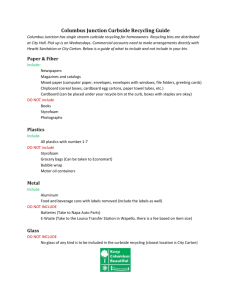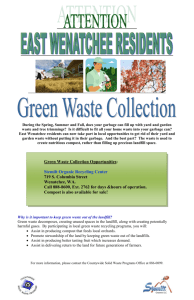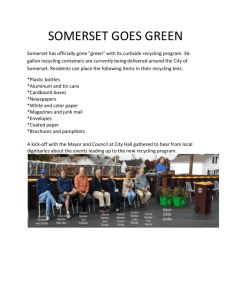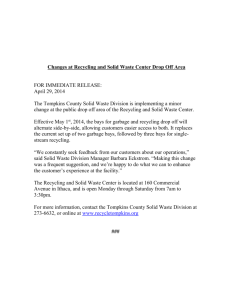5 (Waste Management Strategy Development)
advertisement
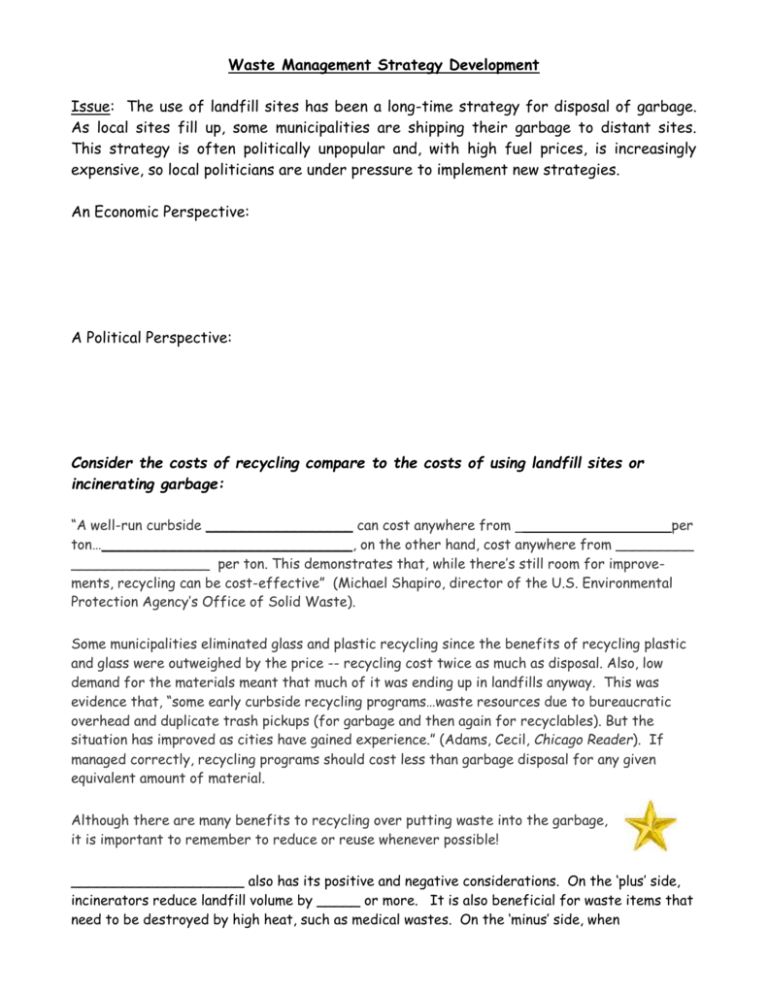
Waste Management Strategy Development Issue: The use of landfill sites has been a long-time strategy for disposal of garbage. As local sites fill up, some municipalities are shipping their garbage to distant sites. This strategy is often politically unpopular and, with high fuel prices, is increasingly expensive, so local politicians are under pressure to implement new strategies. An Economic Perspective: A Political Perspective: Consider the costs of recycling compare to the costs of using landfill sites or incinerating garbage: “A well-run curbside _________________ can cost anywhere from per ton…_____________________________, on the other hand, cost anywhere from _________ ________________ per ton. This demonstrates that, while there’s still room for improvements, recycling can be cost-effective” (Michael Shapiro, director of the U.S. Environmental Protection Agency’s Office of Solid Waste). Some municipalities eliminated glass and plastic recycling since the benefits of recycling plastic and glass were outweighed by the price -- recycling cost twice as much as disposal. Also, low demand for the materials meant that much of it was ending up in landfills anyway. This was evidence that, “some early curbside recycling programs…waste resources due to bureaucratic overhead and duplicate trash pickups (for garbage and then again for recyclables). But the situation has improved as cities have gained experience.” (Adams, Cecil, Chicago Reader). If managed correctly, recycling programs should cost less than garbage disposal for any given equivalent amount of material. Although there are many benefits to recycling over putting waste into the garbage, it is important to remember to reduce or reuse whenever possible! ____________________ also has its positive and negative considerations. On the ‘plus’ side, incinerators reduce landfill volume by _____ or more. It is also beneficial for waste items that need to be destroyed by high heat, such as medical wastes. On the ‘minus’ side, when considering incineration, a large concern is that municipal waste combustion and gasification should not be considered to be renewable energy. ______________discarded materials saves __________ times more energy as could be made by combusting the same materials. Further, waste combustion and gasification both create toxic air pollutants (including dioxin) and both create contaminated byproducts including ash, slag and liquid residues. Why do municipal recycling programs recycle only a limited number of items? All curbside programs differ, but the most commonly included materials are “The Big Five:” 1. 2. 3. 4. 5. Reasons to avoid putting the following in the recycling box: _____________________: The oil from pizza can contaminate cardboard boxes, making it impossible to process them into clean paper. ________________________: It's not the paper goods themselves that present a problem, but the fact that they're typically used to wipe up food, cleaning products, and other "hazardous waste." (BUT, these can typically be put into your Green Bin) ____________________: Their size, color, and the adhesive strip make them a better bet for the trash bin. ____________________: Curbside programs won't recycle them, but Aveda collects them and turns them into packaging for new products. ____________________: Paper fibers that have been exposed to water are shorter and therefore less valuable to paper mills, making it unprofitable to collect and recycle. Figuring out which plastics you can recycle is often confusing. Most curbside programs only take plastics labeled #1 and #2 on the bottom. Shape sometimes plays a role. For example, many communities don't accept tubs (mouth wider than base), but will take bottles (base wider than mouth) even if the numbers are the same because these plastics are manufactured differently (Lori Bongiorno, http://green.yahoo.com/blog/the_conscious_consumer/3/surprise-five-things-you-can-trecycle.html) Categories of Waste Recyclable -_____________________________________________________ to prevent waste of potentially useful materials, reduce the consumption of fresh raw materials, reduce energy usage, reduce air pollution (from incineration) and water pollution (from landfilling) by reducing the need for "conventional" waste disposal, and lower greenhouse gas emissions as compared to virgin production. Toxic (a.k.a. hazardous waste) -waste material that can cause _________________________________________. It can be spread quite easily and can contaminate lakes and rivers. Biodegradable -typically originating from _______________________________, which may be broken down by other living organisms (____________________) through _________ ___________________ decomposition Organic -a type of ______________________ - from animal and plant materials; also containing ____________ compounds. Inorganic -waste material such as _________________________________________ materials which are only slightly affected by the action of organisms. Inorganic wastes are _____________________________________________________. Other Acronyms of Importance -non-toxic, non-flammable chemicals used in the manufacture of aerosol sprays, blowing agents for foams and packing materials, as solvents, and as refrigerants. In the stratosphere, the chlorine from CFCs destroys ozone, a gas that absorbs harmful UV radiation, at the rate of up to 100,000 ozone molecules per chlorine atom. As of January 1, 1996, most CFC manufacture has been banned in 148 countries that signed the Montreal Protocol, a measure to protect the ozone layer. -an organic compound (from a fossil fuel, like coal) that contains at least one chlorine atom; have a large variety of uses, including synthetic rubbers (tires, shoes), plastics, anesthetics, industrial solvents, part of Teflon, insecticides, refrigerant. Many pesticides contain chlorine. (i.e., DDT) and many of them have been banned in various countries. PCBs were once commonly used electrical insulators and heat transfer agents. Their use has generally been phased out due to health concerns. PCBs were replaced by polybrominated diphenyl ethers (PBDEs), which bring similar toxicity and bioaccumulation concerns. -the plastic commonly used to make milk and water jugs and two liter soda bottle bases -the plastic used in cellophane wrap, diaper liners, and some squeeze bottles -a chemical used to control moths, molds and mildew, and also to deodorize restrooms and waste containers. At room temperature it is a colorless solid with a strong, pungent odor, usually associated with mothballs. Very high exposures can cause dizziness, headaches and liver problems. Exposure occurs via contaminated fish consumption, breathing air around mothballs or wherever p-DCB is used or manufactured. Infants can be exposed by drinking breast milk from mothers exposed to p-DCB. -a plastic used in flooring, records, vinyl siding, shower curtains, and garden hoses. -a metal of relatively high density, >5, or of high relative atomic weight, especially one that is poisonous like mercury or lead Methods of Waste Disposal - Summary 1. Decomposition (a.k.a. landfill method) …already covered 2. Combustion (a.k.a. incineration) …already covered, but here’s some more information: Combustion is a __________________________. In addition to reducing volume, combustors, when properly equipped, can . Incineration facilities can also . A variety of pollution control technologies significantly reduce the gases emitted into the air, including: Scrubbers— Filters— Burning waste at extremely high temperatures also destroys chemical compounds and disease-causing bacteria. Regular testing ensures that residual ash is non-hazardous before being landfilled. About ten percent of the total ash formed in the combustion process is used for beneficial use such as daily cover in landfills and road construction. 3. Pyrolysis (a.k.a. gasification) Pyrolysis is a form of decomposition which takes place in an environment with . Advantages: Conversion of over _____ of waste with no harmful residues _________________ and other harmful gas emission into the atmosphere Reduced public health risk Wide range of waste fuel input Low capital and operation costs Reliable energy source Produces carbon credits according to Kyoto Protocol mechanisms Waste materials treated by the Waste Conversion Technology: municipal solid waste automobile tires wood waste PCBs, plastics sewage sludge oil sludge industrial waste rubber goods of all types agricultural waste containing herbicides and pesticides varnish-and-paint waste (Greenlight Energy Solutions, http://www.glesllc.com/en/energy_dep/what_pyrolysis.html) Collection and Storage of Waste 1. Recycling 2. Composting 3. Landfill - 4. Compactor - 5. Enzyme digester - . This natural “dust to dust” process that constantly occurs in our environment keeps waste material from overrunning us. The four basic enzymatic systems are those that break down fats and greases (_______________); proteins (________________); cellulose such as wood, cotton and paper (__________________); and carbohydrates and starches (_______________). They are non-toxic, non-irritating, non-gaseous, non-flammable, nonpathogenic and typically safe to use. There are thousands of different enzymes, each having specific, individual characteristics. Their enzymes are especially effective in controlling ___________ caused by a buildup of organic soils in restrooms, plumbing, carpets and floors. 6. Flocculation Tank - Flocculation is one step in the water and wastewater treatment process. In a flocculation tank, the . Chemicals (most commonly "alum") are often added to the water going into a flocculation tank to help aid particle formation. Technological Developments in Waste Management Accelerated Waste Aeration - Bioremediation - -often used during, or after, a contaminant incident (i.e., NOT ________________) -used to attack specific contaminants, such as chlorinated pesticides that are degraded by bacteria, or a more general approach may be taken, such as oil spills that are broken down using multiple techniques including the addition of fertilizer to facilitate the decomposition of crude oil by bacteria

